 |
Brain-Mind
Evolution (Threesological) Page VI |
 |
(The Study of Threes)
http://threesology.org
A discussion about the development of the brain also entails a discussion of the mind; of which the different varieties of thought has led many to suspect there may be an underlying difference in brain functioning if not brain development... whether we of the present day and age have the necessary "mental" or technological means of comprehending structural differences that may involve unrealized brain changes through a process of evolution not yet considered.
I am not talking about the current ideas revolving around presumed differences in axon/dendrite functions, more/deeper hemispheric convolutions or complexity of neuron entanlgements. I am talking about the possible existence of something we don't yet realize exists. Far too often our presence in "modern" day events assumes an arrogance of definitiveness expressed with words such as "advanced", "best", "ultimate", etc., when in fact we should rightly assume an ignorance that necessitates a circumspective humility.
In our contemplative efforts to reconcile observation and fact, many of us take exception with present "common sense" notions such as the existence of genetic differences amongst individuals as "the" explanation for dissimilar brain activity. Although such a consideration is quite distant from more general statements such as they're older (thus being more experienced, and wiser), they have more education, they have an "old soul", etc.; we want to know not only what the underlying genetic differences are, but but what brought about the differences as well as what brought about the particular genetic substrate in the first place. Is it to be explained solely or partially as an act of randomness, serendipity, chance, or, if I may be forgiven a term that is sometimes viewed perjoratively, by way of intelligent design? Even though the "intelligence" in this case may be on the order of precursor fundamentals with a "design" (pattern) that repeats due merely to structural parameters (such as the repetitiveness in doodling, or as a better example, the concentric rings seen in a pool after a stone is dropped in) and not by way of a "hands on" (moment-by-moment God directed) implementation. After-effects that repeat, need not have a religiously defined origin of intention. Intentions, on the other hand, can spur unintended associations, as many of us have learned from personal experiences in social circumstances or in private, personal efforts at a given task. Accidents do occur.
Metaphorically speaking, some people may be able to think outside one or another conventional boxes of ideas because their brain may not only contain different packaging materials, or the contents are arranged differently (though the same packaging materials are utilized), but the box itself may be fractionally different in terms not related to a present day understood 3-dimensional space (Length- Width- Height); without having to be understood in terms of multiplicity such as "multi-dimensional", "fractal", "diversity", "plurality", etc...
In other words, such a person's brain:
- May look the same as everyone else's (defined as a "normal" brain when viewed in MRI scans),
- It may weigh the same (using conventional tools of weight measurement),
- And their skull is not viewed as exceptionally different than others;
...yet "for some reason" (other than can be accounted for in their personal sociological history), they think differently... and may be different than any of their family members who shared many of the same sociological circumstances... or so it would seem at least when examined from a general enquiry of comparison.
Perhaps it is needless for it to be mentioned that the normal and rational "common-sense" in one time and place may be viewed as immoral, stupid or even insane in another, with the values of "time" and "place" not necessarily measured in centuries, years, or months, but by shorter spans of time and distances within one's visual or social purview. Then again, present standards of exceptional ability, be it in a physical or mental form, would not necessarily have been viewed in a similar fashion in the past... even in the same language-based culture. For example, while we of the present have standards for courtship and obtaining food, the standards employed by ancient hominids might well justifiably be viewed as brutish and disgusting. It is hard to say what they would think of us while viewing our so-called modern-day "normal" behavior. With such said, it is clear that a development of the brain should at the very least give some mention of mental development over the ages, even if our interpretations of past ideas is based largely on second-hand information such as anthropological artifacts, which includes written texts.
It is easy to visualize a circumstance in which those that spoke/sung or left written accounts of what we of today believe to be actual past events, were viewed by some of their contemporaries as strange individuals. Such individuals might well have exhibited a "futuristic" type of mental perspective (keeping in mind their idea of a future would be different from our own definitions thereof). While some of them may have been stoned, hung, garroted, stabbed, poisoned, thrown into a bog pit, buried alive, burned alive, executed, starved, etc., byway of law, mob rule, or various machinations, others yet were smart enough to exhibit their time period (contemporaneous) conventional views and mannerisms in social gatherings in order to stave of accusations of being crazy or in league with a source of evil.
Such behavior is not an uncommon occurrence today. Many people have relied upon their ability to "act normal" in a given situation in order to blend in with the crowd so as not to bring any accusatory, retaliatory or despairingly harmful focus upon themselves... all the while trying to scope out a given opportunity to remove themselves from a situation that may eventually require more than just simple acting in order to confirm to others the presence of an existing acceptable likeness, sameness or even group-relevant desirable uniqueness as opposed to an unacceptable form of deviance, as would be defined in a particular day and age, cultural or otherwise social situation.
(Many of those today who "join the crowd" by intentionally exhibiting colloquialisms, tattoos, workplace jargon, sexual exhibitionism/promiscuity, smoking, drinking, drug usage, voyeurism, religious/sport/music fanaticism, look-a-like gang apparel, political interest, body piercing, etc., are doing so in an attempt to conceal an individuality that they consciously or unconsciously fear may bring one or more kinds of censorship if not outright aggression from one or more in their peer group or the "authority/establishment" in their given social sphere.) The "sameness" they are trying to project in order to give an impression of "normalcy" is like a widespread "middle child" birth order phenomenon where a convention of peaceful equanimity is sought through multiple forms of a give-and-take negotiation... except that too much of oneself is in the form of self-abuse, self-denigration, self-defilement which can lead to self-oppression but is unrecognized as such because of the foregoing (and other forms of) mitigation employed to appear "normal" and gain acceptance... usually in terms of a mind numbing mediocrity that, beleive it or not, is at times celebrated.
From an old movie entitled "The Lathe of Heaven", comes the expression:
|
Psychotics live in them— and Psychiatrists collect the rent |
...even though there are a host of others who "collect the rent" (in terms of fees for services, goods such as social workers, psychologists, well (or ill)-intentioned strangers, friends, relatives, and family members who may or may not think of themselves as someone that exploits the vulnerability of another (because they think it is "common sense" to uphold ideas related to the notion "that all's fair in business, love and war"). Of course, there are many others who don't attempt to take advantage of someone unable to look out for their own best interests.
These "others" for the most part, attempt to help the individual by way of providing advice, or educating them on where and how to get medical assistance, food, water, employment, shelter, clothing and sometimes access to a toilet/shower/bath plus toiletries, in addition to social as well as spiritual support if a particular person's circumstances provides the occasion for such an administration.
A psychiatrist on the other hand, evaluates a person's "individuality" based on a medical examination in an attempt to ascertain whether or not there may be some underlying chemical, biological or "organ"-ic reason for a given behavior that has been brought to the attention of those who are claiming something is amiss or, more despairingly, say that someone is off their rocker, lost their marbles, is a few cards short of a full deck, has a screw loose, etc... The "organ"-ic reason may be in the form of a disease or injury to one or more organs; not least of which may be the brain. Although sometimes the organic reason is obvious such as in the case of a gun shot or other projectile wound to the head, other reasons may be subtle and require an extensive bit of detective work since small but multiple and overlapping physiological changes may be involved in a person's uncommon (strange or out of character) behavior that is causing an unwelcomed disruption of one or more lives. Alcohol, drug or sleep deprivation are good examples.
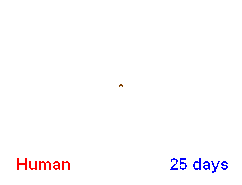
Typically, however, although a given psychiatrist may have a personal hobbyist-like interest in the development of the brain over vast expanses of time, most of their Sherlockian day-to-day pursuits are relegated to an analysis of a particular individual's own life span. (Such as birth trauma, breast/bottle weening, toilet training, childhood trauma, family stability, age of virginity loss, teenage trauma (frequently involving perceptions and definitions of one's "self"), education level, work history, drug/alcohol usage, joblessness, likes/dislikes, minor/major adult trauma, criminal activity, marriage, homelessness, extra-curricular ("fun") interests, etc...) Yet we Threesologists (or Triadologists/Triologists if you prefer), in seeking a "source code" for the prevalence (and evolution?) of the threes phenomena must take a broader, deeper and longer range view that will, in the present context, look at the evolution of the brain from at least one perspective; knowing full well that other perspectives could be offered such as from a strict application of hominid-centered anthropological standards.
Stated another way, our "Threesological" efforts at uncovering a purported "threes source code" (whether or not it can be called a "code" in any conventional sense) arises as a result of accumulating various patterns-of-three examples from a variety of subject areas. At one point or another in our collection's processing we begin to wonder (humorously) what is or may be "THE" prime- good influence, as opposed to a prime- evil (primeval) influence. In our attempts to unravel this mystery, we necessarily turn towards an examination of humanity as an individual spread out in various cultures over spans of time that may be identified as Recorded History, Anthropological History, or Mammalian History, though different perspectives (geology, paleontology, botany, etc...)might prefer to examine various other histories. Since the very many "Threes" examples are made possible because of the human brain, an examination thereof may be fruitful since it appears to be the source, or at least a biological filtering mechanism by which "threes" come into being or are in any respect, recognized.
(Note the "evolving" wrinkled boxing glove outline exhibited in the profile of the developing brain. Perhaps its time for we humans to "take the gloves off" when examining the development of our brain's "individuality". Up till now, it would seem, we have merely been shadow boxing.)
We begin our examination of the brain's development from the perspective of a long-range historical analysis involving Paul D. MacLean's Triune Brain theory. However, we must also make a "Threesological" examination of the brain's hemispherically-denoted attributes as well as process from which the brain itself develops along its Triune course... namely the three Germ layers. The three Germ Layers will necessarily have their own historical pathway that will need examining as well as the "Triune" configuration of DNA, RNA and Proteins. Each of these sets of three appear to antedate (come before) another set of three. Yet, in the final analysis, we must wonder if we are merely imposing a proclivity towards threes organization which hinders a more accurate assessment and interpretation. In other words, has the evolution of the human brain acquired a "threes" perspective proclivity due to a particular time and place in its development and that this perspective will come to change as the brain evolves?
 Standard Model
Standard Model | ||||||
| ||||||
| Cognitive evolution of the human brain | ||||||
Paul D. MacLean one of the early research directors for NIMH, postulated a theory that the human brain is actually the product of three evolutionary changes. As the brain is very dynamic and therefore does not operate via autonomous and separate areas, what MacLean proposed was a kind of general evolutionary map. His theory was cored in the notion that what constituted the human brain was really for the most part comprised of three separate brains which had evolved over very long periods of time. MacLean proposed that the base brain which was instantiated within the human brain at its base was a variation in the elaboration of the reptilian brain. He termed it the R-complex. The limbic system within humans was an elaboration of the new mammalian brain from the Jurassic period. He termed it the mid brain or the neo-mammalian brain (new mammal). As humans are mammals this is fairly straightforward. Finally he termed the large cerebral cortex which encompasses our logic centers, the neo-cortex (new cortex). The following two charts show how this looks from a general function perspective. | ||||||

| ||||||
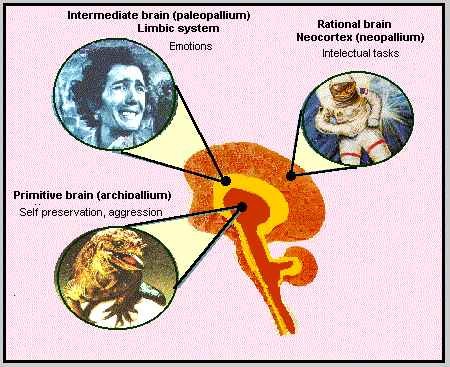
|
||||||
The following chart is a geologic timeline which depicts the three evolutionary changes in the human brain. It maps to Paul D. MacLean's triune brain theory. | ||||||
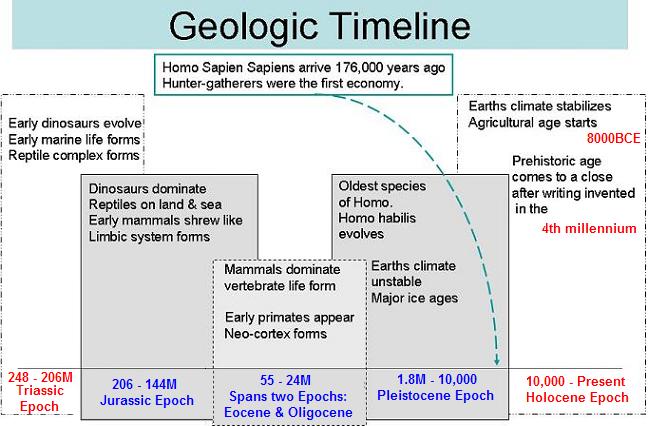 | ||||||
From the imaging studies done over the past two decades using new technologies such as PET, SPECT and fMRI we are gaining increasing insight into how the limbic system functions within our brain functions. When information is taken into your brain from sight, sound, smell and touch it goes directly into the hippocampus. The hippocampus is the receptacle for short term memory where your brain parks data till it has decided what to do it. Since the brain is massively parallel we don't know the exact sequence yet and therefore I will simply address the main two branches which your brain takes with every piece of input data. The Amygdala is paired with the hippocampus and if the data is interesting and not alarming it is packed off to the neo-cortex for comparison with prior experiences and filed into long term memory as the mind rationalizes the data. It could be new thinking or reinforcement of currently held thinking. However if the brain is alarmed by the data then your flight or fight responses react setting off a chain reaction in responses. The following image is of the Amygdala and hippocampus in the brain. | ||||||
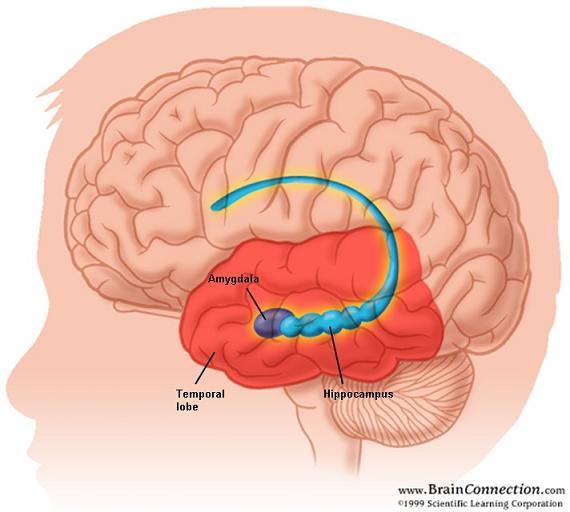 | ||||||
If alarmed the hypothalamus sends out chemicals which heighten your five senses and dramatically decreases your analysis engines blood flow. The brain pumps up your oxygen in order to increase chances for survival. Images taken of individuals exposed to long term trauma, dramatic hippocampal shrinkage were seen when compared with individuals who had not suffered any significant traumas in their lives. You may also have experienced events which scared you to the degree that you simply couldn't speak even though you very much wanted to. This was your brain running in the completely non-verbal fight or flight mode. There are those who feel that this response is the working reaction of the three brains which MacLean postulated in his triune brain theory. Since two of these brains are non verbal the mechanical process of decreasing blood flow to verbal centers is logical as the older limbic system and R-complex are in effect given governance of your mind during perceived crises. This page is what remains from a very theoretical and very large proposed model for human history. I have removed that proposal and will work in the future on developing the data to show how the changes in the world we inhabit continues to be driven by core technology development cycles. I believe these cycles are the primary driver for human history and therefore effect not only the sciences but the arts and social structures which ultimately culminate in updates to worldview. You may review the core technology development cycles here: http://lboeckl.net/model/index.html |
It is easy to appreciate Paul D. MacLean's Triune Brain complex structure and the alignment with physiological development over long expanses of time. Whether or not the "three"-part divisioning will be the definitive "last word" organizational referencing on brain development differentiation is a different historical matter. However, the usage of a anthropologically-focused time-line perspective is a useful tool that may or may not enable the reader to better understand overall brain functioning.
Whether or not you want to accept the notion that some measure of overlapping takes place with these three brain parts, which sometimes invokes the usage of an onion peel analogy, perhaps you will consider that we can also apply a rudimentary numerical labeling system. In such a system we would assign the symbol (or number) "1" to the R-complex since it came first in brain development with respect to the Triune complement of brain structures. Subsequently, the Limbic "system" developed, which, by way of basic numerical counting, places it in the next or second position. Hence, we assign the number (or symbol) "2". After this came the Neo-cortex, to which we can apply the label "3". If another structure should develop thereafter, additional number-symbols can be applied (if not to show addition then to show expansion), unless a future human or non-human species prefers to use some other method of accounting.
Hypothetically speaking, a point of "by the way" interest with respect to the identification of an "R (reptilian)- complex" is to suggest that perhaps an explanation for some types of human "bestial" (non-civil) behavior is to present the idea of an "R" individual (that I humorously call "homo-reptilicus criminalensis") whom we might want even to view as being a different form of hominid that evolved as an offshoot from the so-called "normal" lineage. Whether we view it as a distinctly evolved lineage or a "lineage in the making"... whereby certain individuals grow into the lineage by way of an activated "vestigial receptivity" brought on by one or more types of experiences. (The linneage thus arose and continues from "normal" individuals that "metapmorphocize" or devolve, or mutate into it.) However, it should be noted for those who would not think to consider it themselves, that "non-civil" behavior has its own measure of civility in the context of situations where and when those with this same mindset will gather.
Whereas we customarily think of "linneage" primarily in terms of ancestrally successive forebearers, it may be the case that some people are a part of this linneage but do not exhibit overall characteristics (i.e. such as criminality) unless an individual is subjected to a circumstance (internal and/or external) that triggers what may be called an "awakening", even though most of us might claim that very many criminals act with what appears to be a lack of consciousness. And though it may seem a little weird to say it, a consiousious "normal" individual can be put to sleep while an unconscious "self" awakens.
In other words, their conscious brain is put into a "sleep mode" like a computer, even though it remains able to respond "instinctively." The difference between the sleep mode of a computer and that which a person experiences may not only be depth, but duration and switching mechanism (s). In an inverted analogical sense, some individuals may be closer to the mindset of a sleeping reptile that can more easily be nudged into wakefulness than they can into a sustain "normal" (non-reptilian) consciousness. Such individuals (male or female) no doubt seek out those environments which lend authority to their brand of consciousness, be it crime, war, politics, corporate business, charities (some are legalized scams), or whatever affords them a means to, so to to speak, let down their hair, show their scales and claws, beat their chest, mark out a territory, or trumpet their presence. However, it may not be appropriate for anyone to provide a general statement that all of us are a type of sleeping (criminal oriented) reptile though some readers might want to claim that all of us have the potential for criminal behavior given a certian context and circumstance. Some people may indeed be too far removed from this extreme form of ancestral offshoot branching that any link to a reptilian past is buried in a non-wakeable comatose state. The following image gives some portrayal of the offshoot idea:
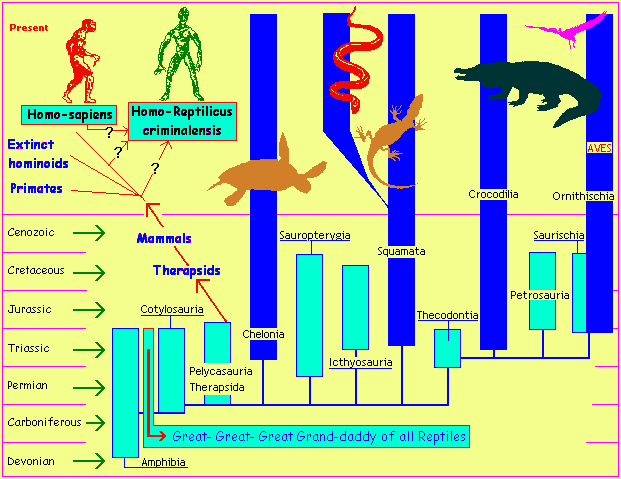
|
"To further complicate the process, it has
been suggested that we have 3 major components in our brain function - instinct,
emotion, and intellect. The 3 layers of function correspond to the major
layers of brain matter that have been added as we evolved through various
stages. Evolution didn't throw much away as humans evolved - our brains
have added new layers on top of what was already there instead of the more
difficult total restructuring or replacement. We still harbor a primitive
reptilian brain at our cores that runs a lot of our subconscious systems like
digestion, respiration and circulation. Along the way we picked up a
number of only marginally compatible and integrated layers, evolving our
conscious minds only with the addition of the outermost layer." Kort E Patterson http://www.hevanet.com/kort/PERCEPT1.HTM |
Whereas we can view the Triune brain theory as it is provided, or we can apply additional information in terms not only by identifying general characteristics such as self preservation (R-complex), emotion (Limbic), and intellectual tasks (Neo-cortex), but by focusing in on more specific attributes relegated to the old and new Mammalian brains that are frequently referred to as the right and left brain hemispheres and apply the number/symbol labeling system to the attributes with respect to underlying functions.
Though this relabeling may seem a bit odd to some readers since it is pairing "old and new" with brain hemispheres and not brain parts as are illustrated above in the Triune brain example, a measure of exploratory license must be granted in order to forestall confusion brought about what might appear to some readers as a contradiction. Simply put, MacLean assigns "old mammalian" to the Limbic system and "new mammalian" to the neo (new)-cortex. For purposes of timeline differentiation, since it is known that the right hemisphere develops in advance of the left hemisphere, we can say that the right hemisphere is the "old mammal brain" and the left hemisphere is the "new mammal brain."
C. Chiron, I. Jambaque, R. Nabbout, R. Lounes, A. Syrota, O. Dulac (Summary) The development of functional brain asymmetry during childhood is confirmed by changes in cerebral blood flow measured at rest using dynamic single photon emission computed tomography. Between 1 and 3 years of age, the blood flow shows a right hemispheric predominance, mainly due to the activity in the posterior associative area. Asymmetry shifts to the left after 3 years. The subsequent time course of changes appear to follow the emergence of functions localized initially on the right, but later on the left hemisphere (i.e. visuospatial and later language abilities). These findings support the hypothesis that, in man, the right hemisphere develops its functions earlier than the left. Now contrast the above with the following: Three types of things babies do a lot of with their mouths:
Basic criteria used by Siobhan Holowka, a graduate student at McGill University, Canada, and Dr. Laura-Ann Petitto at Dartmouth College in their research of infant babbling:
30/08/02 http://www.abc.net.au/science/news/stories/s661715.htm It is of some interest to note that while we can identify a developmental "first" with the right hemisphere, we are inclined to label the emergence of a "first" in the left hemisphere with respect to language. This does not mean that there does not exist one or more "firsts" with the right hemisphere, it is just that we adults, in the context of studying language development, focus primarily on this particular attribute. If we were studying some other hemispherical attribute, it is quite reasonable to suggest we might identify it as a "first", with respect to hemisphere developmental dominance. Both examples came from this page: http://www.threesology.org/language-3s-1.php |
The usage of "old and new" differentiates "before and after" as does a usage of number or letter sequencing (1- 2- 3, 10- 20- 30, A- B- C, X- Y- Z...) when such an explanation is provided at some position during the forefront of a discussion... even though other types of sequencing could just as well be used so long as that which is used has been signified as marks or measures of transition, transposition, movement, etc... As such, interestingly enough, we find that attributes of the right hemisphere (which came after the Reptilian Complex and before the Right Hemisphere), characteristically have an underlying pattern-of-two organization and those of the left hemisphere have a pattern-of-three organization. The reptilian brain thus has the "1" organization attributed to it as is easily suggested by its "self"-preservation orientation. While some may use the 3 alternative designations "me- myself- I" in referencing the "self", each of these either individually or collectively refer to one person. The word "mine" on the other hand could very well mean more than one, though the word "ours" may be more indicative to some readers.
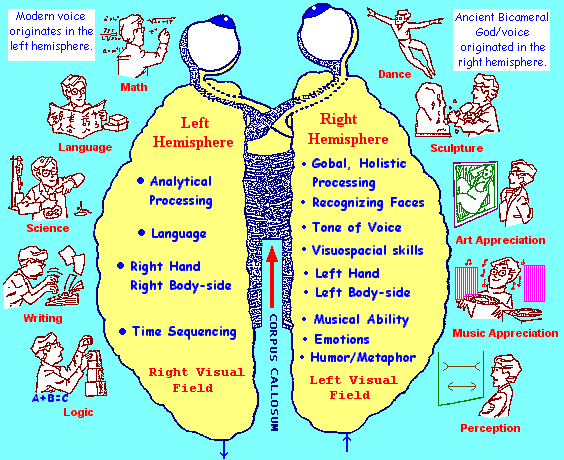
Note: Much of the brain illustration shown above was adapted from page 106 of Dean Falk's book entitled "Brain Dance," 1992.
When we look at the assigned culturally recognized attributes of the brain, we can see a distinct (over-lapping) 1-patterned, or 2-patterned, or 3-patterned arrangement. (Reminder: when a person gets a stroke in the left hemisphere of the brain it affects the right side of the body, and vice-versa.)
| Left
Hemisphere (Predominantly 3-patterned) Math: Associative~ Commutative~ Distributive A2 + B2 = C2 ~ Sine- Cosine- Tangent 1st# (+ - X /) 2nd# = 3rd# Logic: Thesis~ Antithesis~ Synthesis Indulgence~ "Middle Way"~ Ascetism Major Premise~ Minor Premise~ Conclusion Time Sequencing: Seconds~ Minutes~ Hours Past~ Present~ Future Day~ Week~ Month Language - Speech - Grammar: Subject~ Object~ Verb Consonants~ Vowels~ Supra-segmentals Period~ Question Mark~ Exclamation point Right Body Side: Tri-cuspid heart valve Three-lobed lung |
Right
Hemisphere (Predominantly 2-patterned) Holistic: Macro versus Micro Whole versus Part Inner versus Outer Music: Major Scale vs Minor Scale Loud versus Soft (Quiet) Consonance vs Dissonance Visuospatial: (Art) Background vs Foreground Light vs Dark (Contrasts) 1 Dimension vs 2 Dimensions Emotions: Pain versus Pleasure Positive vs Negative Love versus Hate Left Body Side: Bi-cuspid heart valve Two-lobed lung |
 The correlations of two and three being made on this page are not typical considerations. However, I did come across a single reference concerning the tricuspid valve: http://www.madsci.org/posts/archives/mar97/855255174.An.r.html | |
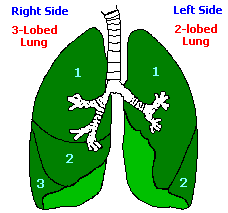 In recognizing that the left lung is smaller than the right lung (which provides room for the heart), let us conjecture that this is due to some past earlier developmental sequence just as we find the 1-layer, 2-layer, 3-layer sequential development of the 3 primordial germ layers (Ectoderm- Mesoderm- Entoderm) in primitive to more complex organisms. Hence, difference in size (dimorphism) as well as a two/ or three prominence may provide another link towards understanding developmental processes. Does this mean that the recurring smallness of the female to the male in many species indicates that females came before the male in terms of species-specific evolutionary development during particular environmental circumstances? If so, will there be an increased development towards a 3 to 1 "fusion" ratio? | |
|
(Reptilian) (Predominantly 1-Patterned) (Self)-Preservation~ (Self)-Procreation~ (Self)-Preeminence | |
Some additional two-patterned references found in music:
- Tension and Release
- Staccato and Legato
- Slow and Fast
- Ascending and Descending
Let us now place the idea of a 1- 2- 3 hemispheric/brain attribute differentiation with overall brain development sequencing. This results in a Mono- (one) Bi/Di- (two) Tri- (Three) portrayal to which we can apply other labels which may or may not provide a readily understood similarity. The following image is one expression of this perspective:
In days of yore (as recounted by H.G. Wells in his "Outline of History") it was considered that humanity may have had a double or treble (triple) origin. While largely discounted, this idea nonetheless provides another example of humanity's thinking processes, that is easily translated into a numerical quanity. The notion once thought was that Africans arose from a gorilla, Asians arose from an orangutan(g), and Caucasians arose from a chimpanzee. Whereas some readers might argue that we could offer examples of other than "three" concepts, thus exhibiting their interest in some other numerical quantity or design; we don't find the same wide-spread usage of other concepts with other-than three formulas. In other words, for example, we don't find the values of 7, 13, or others in usage in so many different areas of human organization about their contemplations. Indeed, if we humans were on the 7th planet from the Sun, our anatomy had a recurring "7" pattern and DNA had a "7" coding system; all of which were not a composite of two or more values, it would pose a significant argument to a "threes" discussion.
Yet, what is not being applied to either of the foregoing theoretical considerations is an earlier occurrence of a 1- 2- 3 maturational development sequence. Specifically, before the brain's triune development (and subsequent attribute designations) came the development of a triune Germ Layer evolution that may have been preceded by a similarly fashioned developmental progression with the "triune/three" of DNA- RNA- Proteins (viewed as a set) that was preceded by the "triune/three" of their underlying triplet code (Adenosine- Cytosine- Guanine/[plus Thymine for DNA and Adenosine- Cytosine- Guanine/[plus Uracil for RNA])... The "triune/three" of Proteins would be: the "primary- secondary- tertiary" structure (with the quaternary as a composite matrix). In other words, the appearance of DNA- RNA- Proteins must have had some sort of independent and/or overlapping development. This must also be true, or so we might consider, with how each of their underlying three-part structures may have developed. Similarly, we could think along this same triune development fashion by considering that the three main cellular energy sources Adenosine monophosphate- Adenosine diphosphate- Adenosine triphosphate [AMP (mono: one)- ADP (Di: two)- ATP (tri: three)] was likewise established though other examples might well be offered by one or more readers; such as whether life 1st began on Mercury then "moved" to Venus, and then "came" to Earth; by luck, chance, freak accident, intention or some sort of reflexive mechanism "inherent" in biological activity within a planetary system.

Whether or not these "triune" (or three-patterned) characteristics are synonymous with that of the maturational progression being explored with brain development is at this point suppositional. And along with this we might venture to guess whether the "triune/three" of the proposed three life domains "Archae- Bacteria- Eucaryota" followed a 1- 2 - 3 developmental trek; or the electron- neutron- proton complex; or the Mercury- Venus- Earth trio; suggesting life as we know it may have begun so many billions of years ago on Mercury, then moved to Venus before arriving on Earth... additionally suggesting this first three may be the first of two sets-of-three yet to come; thereby giving evidence for a mathematically definable progression in terms of a 1- 2- 3 set theory. (By the way, infant vocal expressions labeled "babbling" appear to show a 1- 2- 3 structure in terms of single- double- triple chunking that is follow by a single- double- triple word development usage that is followed by some measure of "threes" usage, whether or not the user is aware of such. This example about developmental language is important since ideas typically are "translated" into words grouped into sentences grouped into paragraphs that may thereafter be grouped into chapters, then a book, then a sequel... unless like in days of old, chapters would be collated into a section called a book, thus there would be several books in a volume that we of the present call a book.)
Let us take a look at the aforementioned three Germ (cell) layers labeled Endoderm- Mesoderm- Ectoderm. But before providing a short definition list of each, it must be stated that these three Germ layers have evolved to produce a complex organism such as we humans...
... Even though animals from flat worms to man grow from three Germ layers (labeled Triploblastic) and have a bilaterally symmetric body design. (Humourously noted, it may not be a coincidence that worms are comically portrayed as being particularly intelligent, or why else would we refer to someone as a book worm? We never hear of a worm being called a book human.)
Less complex organisms have two Germ Layers and are sometimes referred to as Diploblastic such as the cnidarians (coelenterates), which also have radially symmetric body designs.
While the usage of the term "Monoploblastic", along with the idea of a single Germ layer is particularly infrequent during discussions within the context of and about biology as well as the evolution-like spread of ideas in various written forms; the life forms known as protozoans may, conversationally speaking, be described as such. The design of their body is labeled spherical in that their body parts are arranged concentrically (circularly), with no distinct polarity.
The illustration at the left portrays meiosis (sex-cell reproduction) compared to Earth events though the rate of revolution is not clearly depicted. Development on a fast spinning Earth billions of years ago may well have produced the conditions like that of a laboratory centrifuge as opposed to a rate of slower revolution with a more "biologically fashionable" magnetic field polarization from which bilateral symmetry may have been developmentally influenced... spurned by the planet's "polarizing" events now seen in mitosis and meiosis. (Too fast a rotation may not be conducive to a "biological awakening" in that it also produces geophysical instability. In other words, the Earth would not be able to remain or aggregate into a whole because it would spin apart.) Flip-flopping of the Earth's magnetic filed polarity, though visible in rock formations, may not be so readily identifiable in biological substrates if we use conventional methods of analysis, interpretation as well as expectation.
Hence, with respect to the three Germ Layers, we can say that we have a Triune-styled biological formula that precedes the development of the Triune brain complex, even though it may have developed its triune ("3") structure in a 1-to-1 developmental proximity. In other words, one part of the brain such as the R-complex may have had its earliest beginnings within the time-frame development of a single Germ layer and then the 2nd brain structure (compartmentalization) developed within the time-frame of the Second Germ Layer and the 3rd brain structure with the third Germ layer, even if we at present are unable to identify the earliest developmental 1-to-1 correlations, if they occurred at all. In other words, even though we say that the development of the Central Nervous System (brain) occurred by way of the 3rd (Ectoderm) Germ layer, each brain division (R-complex, Limbic System, Neo-cortex) may themselves have, with respect to one another, a progressive three-patterned sequencing development even though this idea may not have been thought of, investigated or documented (as such, differentiated from their placement and time during individualized Germ Layer origination).
In taking stock of the following Germ layer examples, it can be seen that several have a readily identifiable "three-patterned" structure and/or functionality, though alternative forms of "three" assessments may be of value such as placement in conjunction with other examples, activity cycle, growth rate, etc..., to determine if such considerations have any viability for inclusion. For those examples not having a readily identifiable "three" organization (etc.), conjectures might include the consideration that evolution is occurring as we speak and that one day such examples might well have a "three" or something other, including perhaps the distinction of having become a vestigial remnant. Then again, perhaps we humans do not yet have a dominant "three" perspective but will grow into such. Three-patterned examples abound, but many people do not make the connection of their existence.
The Endoderm is the inner-most layer from which the stomach, colon, liver, pancreas, epithelial parts of the trachae, lungs, pharynx, thyroid, parathyroid, and intestines develop (in short, the digestive and respiratory systems).
Colon:
3 bands... Teniae mesocolica~ Teniae libera~ Teniae omentalis
Epithelial parts of the Trachae:
3 basic epithelial cell shapes: Squamous~ Cuboidal~ Columnar
Intestines: 3 parts of the small intestine... Duodenum - Jejunum - Ileum;
3 gastric mucosa regions: Cardic glandular - Oxynti glandular - Pyloric glandular;
Liver:
3 coats of the gallbladder: Serous - Fibromuscular - Mucous (Gallbladder sits below right lobe of liver)
Lungs:
Right lung has three lobes, left lung has two lobes.
Pancreas:
Parathyroid:
Pharynx:
3 single and 3 pairs of cartilage compose the frame (skeleton) of the larynx.
Stomach:
3 stomach wall fiber layers: Longitudinal~ Circular~ Oblique
3 types of (digestive tract) epithelial cell junctions: Tight~ Desmosome~ Gap
3 digestive enzymes: Glycerol esterhydrolase - Cholesterol esterase - Phospholipase A2
3 substances regulating HCL (gastric acid): Acetylcholine - Histamine - Gastrin
3 increased acid secretion phases in response to food: Cephalic - Gastric - lntestinal
Thyroid:
The Mesoderm is the middle layer from which the skeletal muscle, skeleton (bone), cartilage, dermis of the skin, urogenital system, urinary bladder, lining of the urethra, heart, blood (lymph cells), kidney, spleen, and connective tissue develop.
Blood (lymph cells):
3 main cellular components of Blood: Red blood cells~ White blood cells~ Platelets
3 blood plasma protein groups: Globulin~ Albumin~ Fibrinogen
3 white blood cell (leucocyte) groups: Granulocyte~ Lymphocyte~ Monocyte
3rd corpuscle: alternate name for platelets
*** Band 3 protein is complex molecule in red blood cell (erythrocyte) membranes
3 letters (and combinations thereof) used for blood typing: (A~ B~ 0)
3 main blood channels: Veins~ Arteries~ Capillaries
3 interferon types: (White blood cells)~ (Fibroblasts-connective tissue)~ (Lymphocytes)
Cartilage: 3 types... Fibro - Elastic - Hyaline
Connective tissue:
Dermis of the skin:
3 skin layers: Epidermis - Dermis - Subcutaneous Tissue
3 skin layers: Epidermis - Dermis - Subcutaneous Tissue
3 burn degrees (corresponding to skin layers) : 1st degree burn - 2nd degree burn - 3rd degree burn
Heart: 3 layers... Endocardium~ Myocardium~ Pericardium
Kidney: 3 sequences of development: Pronephros - Mesonephros - Metanephros
Skeletal muscle:
3 muscle types: Striated~ Cardiac~ Smooth
3 muscle divisions: Head~ Belly~ Tail
3 gluteus muscles: Maximus~ Medius~ Minimus
3 muscle fiber arrangements: Unipennate~ Bipennate~ Multipennate
3 masseter muscle parts: Superficial~ intermediate~ Deep
3 muscle heads: Biceps~ Triceps~ Quadriceps ("Quadricep" refers to Musculus Triceps Surae, the Plantaris is counted separately) {another 3:1 ratio}
3 muscle (contrasts) definitions: Superior/Inferior~ Major/Minor~ Posterior/Anterior
3 lateral vertebral muscles: Scalenus anterior~ Scalenus medius~ Scalenus posterior
3 peroneal/fibular muscles: Peroneus brevis~ Peroneus longus~ Peroneus tertius
3 general muscle attachment types: Superficial fascia~ Deep fascia~ Subserous facia
3 eyelid muscles: Levator palpebrae superioris~ Obicularis oculi~ Corrugator supercili
3 columns (with 3 subdivisions) of the erector spinne (sacrospinalis) muscle mass:
(Lateral column): Ilicostalis lumborum~ lliocostalis thoracis~ llicostalis cervicis;
(Intermediate column): Longissimus thoracis~ Longissimus cervicics~ Longissimus capitis;
(Medial column): Spinalis thoracis~ Spinalis cervicis~ Spinalis caphis
3 divisions to the transversospinalis muscle group:
(1) Semispinalis thoracis~ Semispinalis Cervicis~ Semispinalis capitis
(2) Multifidus muscles
(3) Rotatores thoracis~ Rotatores cervicis~ Rotatores lumborum
3 muscles of the human nose: Procerus - Nasalis - Depressor septi
3 orbicular muscle portions: Pars orbitlis~ Pars palpebralis~ Pars lacrimalis
Skeleton (bone):
3 possible bone formation sites... Intramembranous - Endochondral - Heterotopic;
3 stages of bone development... Membranes - Cartilaginous - Osseous;
3 bone layers... Concentric - Circumferential - Interstial;
3 bone cell types... Osteoblasts - Osteocytes - Osteoclasts;
3 functions of human skeleton: Support~ Protects organs~ Movement (with muscles)
Spleen:
Urethra (lining):
Urinary bladder:
The Ectoderm is the outer-most layer from which the Central Nervous System (brain and spinal cord), lense of the eye, ganglia nerves, pigment cells, head connective tissues, epidermis, hair, and mammary glands develop.
CNS (central nervous system; brain and spinal cord):
3 expansions of neural tube produce: Forebrain~ Midbrain~ Hindbrain
3 successive brain divisions: Hind/Midbrain~ Limbic system~ Cerebral cortex
3 brain and spinal cord layers: Pia Mater~ Dura Mater~ Arachnoid process
3 Spinal Cord white-matter columns: Dorsal Funiculus~ Lateral Funiculus~ Ventral Funiculus
3 pounds: common reference to the weight of the human brain
3 stages of brain development: Reptilian~ Mammalian~ Neo-mammalian
3 lobes on each Cerebellum hemisphere: Blocculondodular~ Anterior~ Posterior
Spinal Cord white matter columns: Dorsal Funiculus - Lateral Funiculus - Ventral Funiculus
Epidermis:
The Epidermis is the middle of three skin layers: Dermis- Epidermis- Sub-cutaneous tissue
Ganglia nerves:
Hair:
3 layers of dead cells make up a hair shaft: Medulla~ Cortex~ Cuticle
Head connective tissues:
Lense of the eye:
3rd eye in humans is referred to as the "mind's eye"
Mammary glands:
Pigment cells:
Herb O. Buckland
herbobuckland@hotmail.com